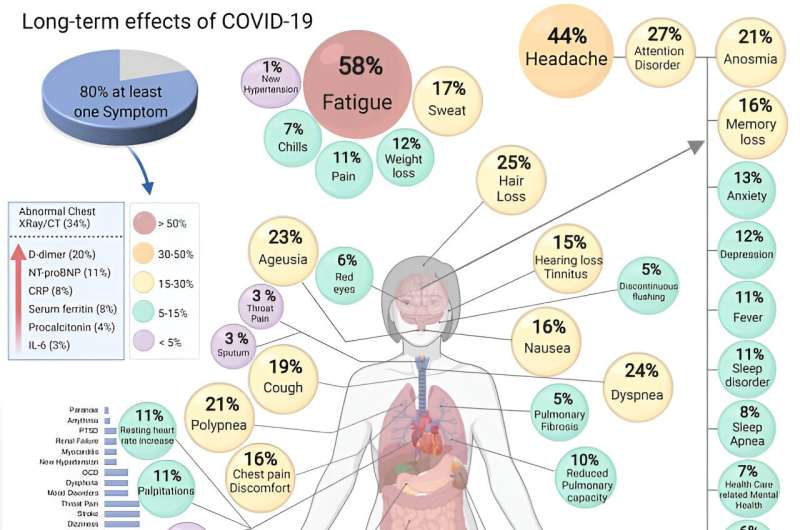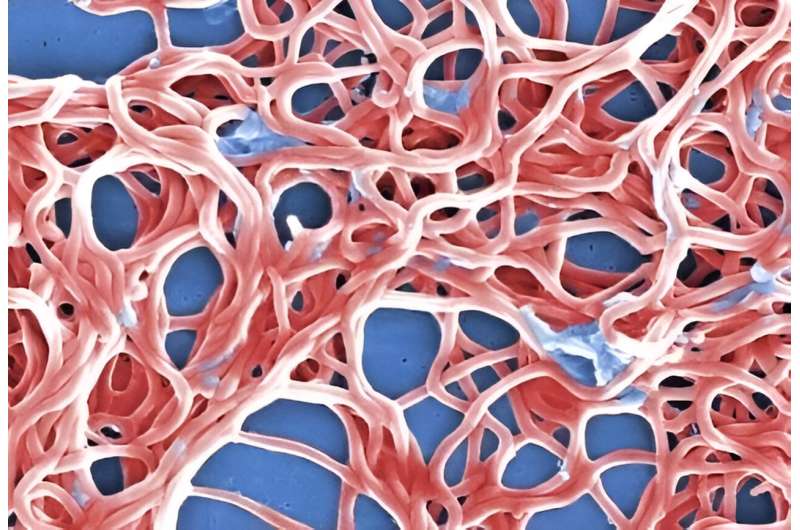This article has been reviewed according to Science X's editorial process and policies. Editors have highlighted the following attributes while ensuring the content's credibility:
fact-checked
peer-reviewed publication
trusted source
proofread
From infection to chronic illness: Learning from long COVID

Since the COVID-19 pandemic, SARS-CoV-2 has caused unexplained, chronic, post-infection symptoms in survivors. The phenomenon, known as post-acute sequelae of SARS-CoV-2 infection or "long COVID," surfaced shortly after COVID-19 testing was introduced to the public, and doctors began noting a pattern of onset of chronic fatigue and dysautonomia in patients who had recovered from acute COVID-19 infection.
Yet, SARS-CoV-2 is not the only pathogen that has been linked to chronic symptoms. While there are known links between bacterial and viral infections with post-acute infection syndromes, much is still unknown about the mechanisms that underpin these illnesses or why they occur.
A silver lining of the COVID-19 pandemic is that it reignited research interest in this field. How can we better recognize and treat these chronic disabilities? We dive into the research to better understand the relationship between microbe and host, as well as the immunological landscape these pathogens leave behind.
What microbes can lead to post infection chronic illnesses?
Epstein-Barr Virus
The Epstein-Barr Virus (EBV), one of nine known human herpesvirus types, and the most common viruses to infect humans, has long been associated with an array of different diseases and conditions, including systemic lupus erythematosus, Sjögren syndrome and MS.
This double stranded DNA virus is primarily transmitted through saliva, earning it the moniker "the kissing virus" and is the known etiological agent of infectious mononucleosis.
The principal targets of EBV infection are B cells, the type of white blood cells that make antibodies. EBV can directly infect B cells in the oral cavity or access them indirectly via oral epithelial cells. Following infection, EBV can establish lifelong latency in infected B cells. Reactivation of EBV can be triggered by stress or immunosuppressant treatment. Upon reactivation, the virus can be transmitted to new hosts.
Researchers have been focusing on pathogenic mechanisms that lead to post infection chronic stimulation of the immune system. One hypothesis is that pathogen remnants (i.e., viral RNA), which contain pathogen associated molecular patterns (PAMPs) stay in the host at undetectable levels and persistently activate host pathogen recognition receptors.
Constant activation of these receptors can cause continuous inflammation, subsequently damaging host tissue and potentially initiating autoimmune activation. This is not exclusive to EBV and applies to a wide range of post-acute infection syndromes.
The establishment of latency to later propagate throughout a host's lifespan may help explain the connection between EBV and autoimmune activation. One example is the link between Pityriasis lichenoides chronica (PLC) and EBV.
PLC is a rare skin disease that results in scaly, red or brown bumps across the trunk and extremities, which can come and go (relapsing and remitting) for months to years. Research indicates that PLC papules are remnants of different subsets of overactivated T cells that remain after viral infections.
While the cause of PLC ultimately remains unknown, it has been linked to EBV as a hypersensitivity reaction in patients with elevated EBV titers. It is still unknown whether recent infection alone is the cause of PLC, or if there is more to this immune dysregulation that gets repeatedly activated from previous EBV infection.
Similarly to EBV, post-infected COVID-19 patients have been diagnosed with the inflammatory rash Pityriasis Lichenoides et Varioliformis Acuta.
Another hypothesis on the cause of post-acute infection syndromes is that acute infections may induce autoimmune activation by impairing regulatory T cells or through molecular mimicry of self-antigens by the pathogen.
Studies have shown that EBV is linked to a >30-fold increased risk of developing MS, and an EBV protein (EBV nuclear antigen 1) has been found to elicit auto-antibody cross reactivity with central nervous glial cell adhesion molecules of the host.

Borrelia burgdorferi
Borrelia burgdorferi is another example of a pathogen that appears to cause post-acute infection syndromes. B. burgdorferi is the bacterium that causes Lyme disease and is transmitted to humans by blacklegged ticks in different regions of the U.S. and abroad.
While Lyme disease can be treated with antibiotics, post-treatment Lyme disease syndrome (PTLDS) is a rising health concern. PTLDS is a condition where patients experience chronic fatigue, pain and cognitive dysfunction for at least six months following antibiotic treatment and clearance of infection.
There is debate in the Lyme disease research field about the plausibility of PTLDS as a syndrome caused by Lyme disease itself, as many symptoms associated with PTLDS are seen in other post-acute infection syndromes. The U.S. Center for Disease Control (CDC) does recognize long term symptoms associated with post Lyme disease clearance as PTLDS.
Potential causes of PTLDS may be permanent tissue damage following infection, an activated autoimmune response or an undetectable ongoing Borrelia infection. However, ongoing infections in the context of PTLDS have not been seen in clinical settings, and the CDC recommends that the term "Chronic Lyme disease" not be utilized as it implies that there is an ongoing bacterial infection causing PTLDS symptoms when the cause currently remains unknown.
One hypothesis on cause of PTLDS is loss of "tolerance building." In "tolerance building" carrier hosts show no symptoms of Lyme disease (i.e., arthritis, carditis) because an immune tolerance has been built to essentially ignore the bacteria, similar to how we mitigate inflammation in the gut microbiome with commensal bacteria.
Linden Hu, M.D., a professor of immunology at Tufts Medical school, describes in ASM's Meet the Microbiologist podcast how this loss of tolerance building in humans may contribute to increased inflammation detrimental to the host.
"If you knock out genes in animals that are involved in the innate immune pathway, you would have predicted that you'd get less inflammation, but what we actually see in many cases where you knock out components of the innate immune system is that you get increased inflammation," Hu explained.
Researchers have found that B. burgdorferi infected patients with single nucleotide polymorphisms (SNPs) in the pathogen recognition receptor Toll like receptor 1 have higher inflammatory responses and subsequent antibiotic-refractory Lyme arthritis.
Recently, Hu's group identified how a complex transcriptional network gets reprogrammed in macrophages during Borrelia infection to modulate long term inflammation in Lyme arthritis.
Excitingly, in 2023 the National Institute of Allergy and Infectious Diseases (NIAID) announced it awarded five project awards to fund PTLDS research citing the urgent need for more information as vector borne diseases are increasing in the U.S.
SARS-CoV-2
A COVID-19 infection tends to last about 4–14 days, while long COVID is defined as persistent symptoms lasting 4 weeks or longer following COVID-19 infection with no other infection diagnosis. Symptoms include fatigue, post-exertion malaise and dysautonomia.
Patients also may experience other debilitating symptoms, including dizziness, migraines and brain fog, and research indicates that COVID-19 can activate other post-acute infection syndromes, including postural orthostatic tachycardia syndrome (POTS).
POTS is a chronic disease that prohibits patients from standing for long periods of time and increases heart rate in sitting or standing positions due to autonomic nerve damage and subsequent functional dysregulation. Although these symptoms are present because of POTS, it is unknown whether permanent tissue damage itself further contributes to disease progression.
In some long COVID patients, extensive organ damage (lung, heart and cardiovascular tissue) and the inability to fully repair these tissues may contribute to continued chronic disability.
Interestingly, SARS-CoV-2 can also induce auto-antibodies against G-protein coupled receptors, (GPCRs), which have been linked to different autoimmune disorders.
GPCRs play a role in modulating host immune responses in regulating effector cell trafficking and response to migration cues in the immunological environment. Therefore, GPCR auto-antibodies can cause microscopic damage to vascular tissue, which ultimately induces vascular remodeling and systemic autoimmunity by chronically targeting GPCRs and triggering a cascade of inflammatory cytokines.
These proposed mechanisms of post-acute infection syndromes are not necessarily exclusive and may activate each other in overlapping cycles. Questions about whether permanent tissue damage resulting from COVID-19 may be contributing to disease progression of long COVID remain unanswered.
What do these post-acute infection illnesses look like for patients?
The impact of post-acute infection syndromes on daily activities and overall quality of life can be devastating and, in some cases, lead to long-term disability. POTS and PASC were greatly highlighted as the COVID-19 pandemic progressed. Stories shared about the severity of PASC on relatively young and healthy individuals has helped promote advocacy for more research in this field.
Furthermore, these stories have helped break the stigma surrounding post-acute infection chronic disability health care. Multiple news and media outlets have have covered the toll long COVID has had on completely reordering patients' lives. These stories describe patients' loss of ability to work and perform basic cognitive abilities, such as remembering how to perform oral hygiene care.
How can we better detect and diagnose?
The onset of chronic disability associated with post-acute infection syndromes is not limited to the pathogens discussed in this article. Other pathogens, including Ebola virus, Coxiella burnetii, Chikungunya virus, West Nile virus and Camylobacter also have associations with long term chronic diseases. Yet their causes and pathology remain relatively unfamiliar to the medical community.
Since there is no standardization in diagnosis, post-acute infection syndromes are often dismissed as signs of other, more common, illnesses (chronic fatigue syndrome, fibromyalgia, depression, anxiety, etc.) or misinterpreted as cardiac or neurological abnormalities.
Furthermore, when these syndromes are recognized/diagnosed, patients often experience delays (or absence of) proper treatment, due to a lack of standardization in treatment plans for chronic illnesses. Patient health and well-being continues to diminish as a result.
Fortunately, in the aftermath of COVID-19, chronic illness has garnered more support, and biomedical research has received additional funding to further elucidate the causes of post-acute infection syndromes. Bettering our understanding of the mechanistic causes will allow us to create appropriate diagnosis standards and increase quality of life for those suffering with these chronic disabilities.



















